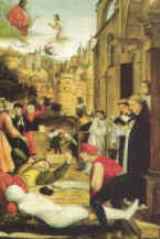Tragic Times in Europe
Tragic Times - 100 Years' War, Papal Schisms, Bubonic Plague, Flagellant Heresy - in the 14th and 15th Centuries
Return to the previous section where the Blessed Mother instructs St. Dominic to use her (Marian) Psalter in his preaching in order for it to bear fruit.
The Confraternity of Prayer founded by Saint Dominic thrived for a short period, then all but disappeared after only a century. Just then, European history entered tragic times. Namely, the Hundred Years’ War (1337-1453) (brought on by English King Edward III’s claim to the French throne and English attempts to take over land in continental France) caused many casualties and civil wars in both countries. Then the office of Pope began to weaken under worldly pressures, leading to its splitting two, then three ways – which ultimately helped open the way for the Protestant Revolt. Tragically, the Bubonic Plague killed tens of millions in a mere three years, giving way to the heresy of the Flagellants. The next three paragraphs offer some interesting details of the papal schisms (divisions), the plague and the Flagellant heresy.
Papal Schisms - Pope Clement V succumbed to the influence of the French crown by moving the papacy in 1309 to Avignon France, where it remained until 1376. After its return to Rome, a newly-elected Pope Urban VI chastised the French cardinals for being too worldly, so they returned to France and elected another Pope, Clement VII, in 1378. This tragic division in the Church led to a third pope, Alexander V in 1409, but was finally settled with the installation of Pope Martin V in 1415. These papal schisms, and the Church’s material indulgences and political corruption that continued over the next century, seriously undermined the papacy’s prestige and credibility, thereby preparing the way for the Protestant Revolt sparked by Martin Luther in 1517.
 Bubonic Plague - Also during this time of papal upheaval, Almighty God allowed an epidemic known as the Bubonic Plague to spread first in Bubonic Plague - Also during this time of papal upheaval, Almighty God allowed an epidemic known as the Bubonic Plague to spread first in
the East, then throughout Europe. From 1347 through 1350, this horrifying and excruciating ‘Black Death’ killed about one third of Europe’s population, or 20 million people. People died so quickly – within one to several days – and in
such staggering numbers, that they could not receive the last Sacrament of Extreme Unction, today known as the ‘Sacrament of the Sick or Dying’. Therefore, Pope Clement VI issued a general blessing of forgiveness for those who perished.
Flagellant Heresy - The heresy of the
Flagellants grew out of the common belief that the Bubonic Plague was a manifestation of divine anger for the evils of the day. The Flagellants believed they could help appease God’s just anger by performing extreme public penances; and so they would wander through towns and countrysides whipping themselves as a sacrifice for sins, in imitation of Christ’s atoning scourging (the Rosary's second Sorrowful Mystery). The name ‘Flagellant’ comes from the Latin word ‘flagellare’ meaning ‘to whip’. In 1349, the Pope condemned this heresy and ordered authorities to suppress the Flagellants, of whom society generally disapproved.
What role did the Holy Rosary take following these tragic times? Continue here with the History of the Rosary.
|